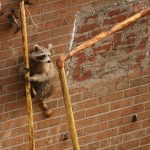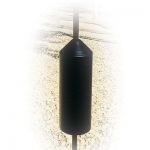How To Keep Raccoons Out Of Bird Feeders
 Have you ever walked outside with your java, hoping to enjoy a few stress-gratis moments watching the birds at your feeder, only to observe it empty? Or worse, laying on the ground in pieces?
Have you ever walked outside with your java, hoping to enjoy a few stress-gratis moments watching the birds at your feeder, only to observe it empty? Or worse, laying on the ground in pieces?
If so, you've probably been visited by a raccoon.
Keeping raccoons out of your bird feeders can be a tricky business concern. Follow the steps outlined here to help keep your feeders raccoon-free and save your sunflower seeds for the birds!
What is a raccoon?
The beginning step to combating whatever pest is to empathize what it is.
Raccoons are, believe information technology or not, closely related to the much more cuddly-looking panda acquit. Although they are considered a pest species, they are not rodents. They are nocturnal creatures–meaning they fodder at night and sleep in their dens during the day.
This time of year, from late spring and for the rest of the summer, these fast-moving little creatures will consume food almost constantly while awake. They are building thick layers of fat on their trunk for winter months, just similar hibernating bears. However, raccoon practice not hibernate. Whenever winter temperatures are to a higher place twenty-eight to thirty degrees, they will come out and fodder for nutrient.
Raccoon brand stubborn opponents
Raccoon will go to swell lengths to steal easy food from bird feeders. With their blackness-ringed optics, they often are and so stealthy that you'll compare a raiding raccoon to a masked bandit. Their dark vision, hearing and acrobatic skills are highly developed. They fifty-fifty have finger-like paws, allowing them to handle and manipulate things that interest them in much the same way a human would. Raccoon tin can unscrew and unhook things just like you can, so a feeder hanging within their grasp volition exist an automatic target.
Even a pole-mounted bird feeder won't be safe on its own. Raccoon tin can climb any pole that is larger than ¼ inch in diameter and have no qualms about jumping or dropping from as high every bit forty feet in the air.
Saving your feeder
Follow these steps or combine a few to help keep raccoons out of your bird feeders.
- Apply a squirrel bamboozle for pole-mounted systems. If your feeder is pole-mounted use a baffle at least iv feet to a higher place the footing. Raccoon will not be able to climb up the pole to reach the feeder. Keep in heed, poles that are close to copse, hanging branches and rooftops will be fair game, even with a bamboozle.

- Do not hang feeders from trees. If raccoon are a problem in your area, using a hanging feeder is probably a bad idea. At that place isn't a way to protect tree-hung feeders from raccoons. You can use S hooks and/or cables to make it more difficult for them to pull the feeder down, but it won't keep a raccoon from shaking the feeder or jumping on superlative of it to attain seed.
- Bring bird feeders inside at night. Although information technology takes a footling extra work, bringing your feeders into the house or garage before night will protect them. Particularly if you're using hanging feeders, this is a practiced idea. Raccoon are primarily nocturnal, but birds are non. By following this strategy during the 24-hour interval, you tin can feed birds when the sun is out, but not raccoons by moonlight.
- Clean up later birds. Try a feeder that catches falling seed and/or apply a college quality seed that birds are less likely to waste product. The fewer nibbles found on the footing, the less likely a curious raccoon is to attempt invading your feeder.
- Keep bird feed sealed. Feeders are not the only places raccoon raid. If you have bird seed in a shed or an unsealed container, you'll probable get visitors there also. Shop your bird food in durable containers with tight-fitting lids. This will keep bird seed safety from all kinds of pests, including the raccoon.
What Not to practice
These tricks, commonly referenced in forums, should be avoided when trying to gainsay raccoon invasions. Remember, these minor creatures might be abrasive, but they are office of the wild landscape as well and some of these techniques could harm wild birds or humans unintentionally.
- Never grease, oil or utilise petroleum jelly to feeder poles or wires. Although it volition keep nigh pests off, the grease can harm birds if it gets on their feathers. Greasy substances can't be hands preened and will leave wild birds more vulnerable to predators.
- Don't shoot a raccoon. Although killing raccoon is legal in well-nigh areas, we don't recommend information technology. Information technology is especially important non to shoot at them. Besides the normal risk of shooting a gun in your k (and it's illegal in virtually urban and suburban areas), raccoon can be carriers of the Rabies virus. If blood or tissue with the rabies virus reaches your skin, eyes or mouth it is fatal to humans.
Here in Florida, nosotros bargain with raccoon invasions on a almost daily bases. Nosotros know these creatures, looking so cute and innocent in pictures, can be every bit sneaky as any well-trained thief. Utilize the steps above to help go on a raccoon out of your bird feeders. If handling the raccoons on your own isn't working, contact your state'southward Department of Natural Resources for help.
What techniques do yous use to proceed raccoons and other pests out of your bird feeders? We would love to read your successes in the comments beneath!
Yous May Also Like
Source: https://www.birdhousesupply.com/blog/how-to-keep-raccoons-out-of-feeders/

0 Response to "How To Keep Raccoons Out Of Bird Feeders"
Post a Comment